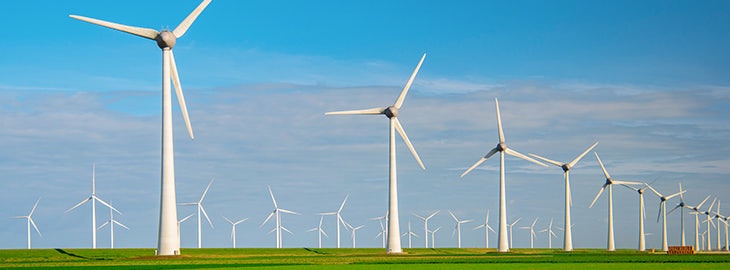Asset managers, operators, and operators of wind turbines have two key objectives: 1) optimizing the availability of wind turbines, and 2) executing the most cost-efficient maintenance strategy possible. In this article, we explain how vibration monitoring contributes to optimizing the availability and maintenance efficiency of wind turbines.
Vibration monitoring provides insight into wind turbine drivetrain
Every industrial rotating machine is subject to vibrations, but when vibrations increase in one or more places in the machine, it is important to determine the cause. The consequences of excessive vibrations should not be underestimated, as they can have catastrophic consequences for people, the environment, and the machine itself.
In the case of wind turbines, it is therefore important to monitor all components of a drivetrain (low-speed shaft, high-speed shaft, gearbox, and generator) for vibrations, as early detection of increasing vibrations and determining their cause significantly reduces the chance of incidents, unexpected high costs, and reduced lifespan.
Vibration sensors on drivetrain
The entire drivetrain is equipped with vibration sensors that continuously measure the vibrations of all components and send them to a data acquisition system. The data is then processed and stored, and periodically analyzed by vibration specialists using advanced analysis software. By periodically analyzing wind turbines, a trend is built up, allowing the vibration specialist to gain insight into the condition of the drivetrain through trend analysis.
Optimization of operational availability of wind turbines
Let’s first look at the first objective, 1) optimizing the availability of wind turbines. Optimal operational availability is achieved by minimizing the chance of unexpected downtime, maximizing lifespan, and optimizing performance.
Minimizing unexpected downtime; maximizing yield
Without good periodic insight into the vibration behavior of the rotating components and thus the machine condition, the chance of unexpected downtime is high. For example, if bearing damage occurs and is not noticed in time due to a lack of insight into the bearing condition, a whole operation needs to be started in the short term to replace this bearing. With periodic vibration monitoring and analysis, such a defective bearing can be detected earlier and better anticipated, significantly lowering the costs of repair.
Moreover, the aforementioned trend analysis contributes to optimizing the yield. Trend analysis can determine whether a bearing with beginning damage can still operate cost-effectively during the season with the highest wind potential (from autumn to spring), or whether it may be necessary to temporarily limit the maximum speed of the respective wind turbine until the summer, when there is generally less wind.
Extending lifespan with vibration Measurements
By gaining early insight into increasing vibration levels in the drivetrain, vibration monitoring can help identify factors that could affect the lifespan of the wind turbine. This allows owners and operators to take measures to extend the lifespan of the turbines and improve overall availability.
Optimizing Performance
Vibration monitoring systems can also be used to optimize the performance of wind turbines. By analyzing the data, engineers can adjust turbine operation to maximize energy production without compromising safety. This contributes to higher availability by improving the yield of the wind turbines.
Optimizing wind turbine maintenance efficiency
And now let’s look at the second goal, 2) executing the most cost-efficient maintenance strategy possible. An efficient maintenance strategy is achieved by making maintenance plannable, or by following a predictive maintenance strategy.
For multiple cost-related reasons, making maintenance plannable for wind turbines is essential for efficient maintenance. The focus is strongly on keeping drivetrain work uptower, as costs significantly increase when drivetrain work has to happen downtower. Unfortunately, it is sometimes unavoidable that drivetrain work needs to be done downtower. In that case, early insight into the condition of the machine is essential to make maintenance plannable due to the complexity of the logistics process. It starts with obtaining the right permits, which takes at least 12 weeks, scheduling one of the few available specialized teams, scheduling a special crane which is also scarce and delivered by about 40 trucks, scheduling the right tools to keep the rest of the drivetrain in place which are also scarce, and obtaining the right machine part.
Additionally, there may be additional costs to consider, such as compensation costs for situations where nearby farmers have to sacrifice part of their harvest to grant access to wind turbines. It may also be necessary to bridge ditches, and consideration must be given to seasonal and weather influences that hinder crane construction due to high wind speeds or muddy grounds.
All this means that when maintenance can be made plannable through vibration monitoring and periodic vibration analysis (and additional techniques), maintenance can be performed in a more efficient way.

